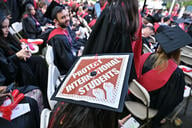You have /5 articles left.
Sign up for a free account or log in.

Faculty and staff members can encourage first-generation and low-income students to make claims on university resources by validating them and their experiences and teaching them how to acquire and use resources.
Drazen_/E+/Getty Images
First-generation students and those from lower-income families can struggle to navigate postsecondary education due to lack of social capital or understanding of the hidden curricula of higher education.
Research published this year from Tyton Partners found, across the board, that many students are unaware of the resources available to them at their institution. First-generation students, however, are more likely to know about students services but less likely to use them compared to their continuing generation peers.
Tyton Partners recommends delivering relevant and specific messaging to students to close usage gaps, including normalizing seeking help for first-generation students. New research from the University of Arkansas’ Becca Spindel Bassett, assistant professor of higher education, found practitioners can employ three strategies to motivate low-income, first generation (LIFG) students to utilize available services.
The barriers: LIFG students, compared to their peers, are less likely to engage with their institution in a variety of ways. First-gen students take fewer credit hours, have fewer non-course-related interactions with peers or less frequently interact with faculty members outside of class, while being from a low-income household means students are less likely to be involved on campus.
“College campuses are exceptionally complex social environments when it comes to resource acquisition,” Bassett says. “Campus resources are almost always ‘opt-in,’ which means students have to make a claim on them in order to receive them.” Student services can also be hidden, require bureaucratic or cultural processes to be utilized, or be gated by various members of authority.
Scholarship in higher education has historically taken an individual-level view of inequality, attributing gaps in participation to students’ abilities or efforts to adopt to the norms of an institution.
“We have these overly individual models in student success, both in higher ed, but I think more broadly in how social scientists conceptualize inequality, where we assume this level playing field and arena of free competition and fair reward, where something like human capital is what differentiates one student’s success from another,” Bassett says. “And I think that really belies these cultural, organizational and power dynamics at play."
Other researchers argue that some students use resources and services at a higher level because they understand the means, processes and relations needed to gain, control and maintain access.
One example is research. To participate in a faculty-led research project, students need to understand interpersonal relationships with professors, understand how to interview, and have the assets such as transportation and finances necessary to participate. Using this framing, students must understand what resources exist and how to access them as well as have cultural, social and symbolic capital.
High-income and continuing generation students are more likely to have confidence in making claims that they deserve resources, including having parents who act as concierges or being socialized at home or school to assert their needs.
“Unfortunately, our institutions and many schools are both built to favor these middle class, proactive, visible forms of claims making and engagement,” Bassett says. “And because of time constraints with faculty members and staff, and under-resourced offices, the most visible and loud students are often the ones who are going to get the precious time of these really helpful people.”
Methodology: Bassett completed a year-long ethnographic study of two universities between July 2019 and July 2020 for her study. Both institutions are nonelite four-year universities with at least 1,000 undergraduates serving and graduating large numbers of low-income and first-gen students.
Bassett recruited 139 staff, faculty and administration from departments and academic colleges to participate, collecting observational, interview and archival data. After March 2020, Bassett’s research transitioned to online data collection, interviewing participants and observing virtually.
In total, Bassett completed 113 in-depth interviews with 91 participants.
While the COVID-19 pandemic disrupted student learning experiences, it was also an external shock to the system that dramatically increased levels of disadvantage for LIFG students, which provided an interesting look at how institutions respond and meet needs, Bassett says.
Bridging gaps: Bassett found, despite the differences between the two institutions, that staff, faculty and administrators used three similar strategies to include LIFG students. Practitioners would:
- Welcome and validate students. Campus members employed a strengths-based approach to student experiences, celebrating first-generation identity and creating specialized events for them. Faculty members also emphasized the value of their lived experiences as it pertains to their academic learning.
- Teach structural and social codes to access resources. Incoming students were explicitly taught which resources were available and how to use them. Orientation events, workshops, advising sessions, panels, one-on-one appointments and required first-year courses served as mediums for instruction on identifying and claiming resources, as well as administrative and academic policies. Students also needed help engaging with professors, whether setting up a meeting or leading a conversation about academic concerns. “At both universities, everyone who touched first-year students felt like part of their job was explaining how the university worked,” Bassett says, which contributed to retention and graduation of LIFG students.
- Legitimize students claims for assistance and accommodations. LIFG can feel hesitant to request assistance for different reasons, whether they need an accommodation due to a family obligation or personal crisis or additional financial assistance to be successful in class. Sometimes institutional policy or procedure, such as in working with the financial aid office, can become barriers to support because students feel misunderstood, minimized or mistreated. Therefore, staff and faculty can serve as advocates and coaches in ensuring students receive the help they need.
For practitioners looking to improve their work with first-generation, low-income students, Bassett suggests asking three questions:
- What are the means, processes and relationships through which resources are distributed?
- Do we teach these processes to students?
- What data am I basing the answer to these questions on?
“It’s helpful to investigate that before assuming that maybe it’s a student’s effort or initiative that’s the problem,” Bassett says, in regard to data collection.
Institutional considerations: While the three strategies were individual in nature, there are opportunities to standardize them across the institution, Bassett says.
One way is through recruitment of faculty and staff who are mission-driven. Both universities Bassett evaluated employed alumni who are more deeply committed to the student population and large number of first-gen learners.
Administration and leadership can also ensure first-generation, low-income students are widely celebrated and validated, not just on National First-Gen Day, but throughout their college experience and in the way the university seeks to serve learners.
Bassett cautions practitioners to avoid thinking a program or scholarship will remove barriers for LIFG learners because often it adds to challenges or frustrations. Instead, consider making resources automatically distributed or part of an opt-out process, to avoid creating a new process or relationship to coach students through.
Get more content like this directly to your inbox every weekday morning. Subscribe here.




